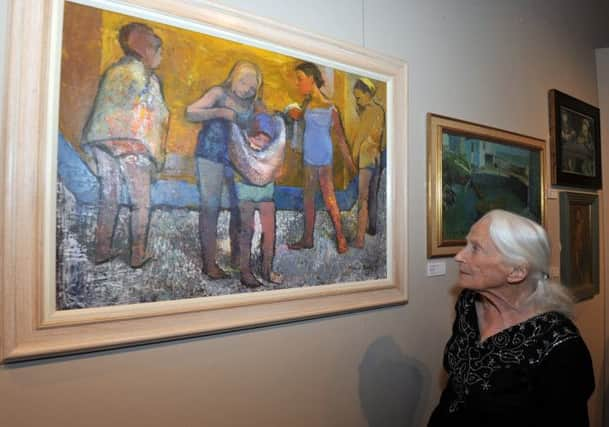Obituary: Moira Beaty, cryptographer and artist


Moira Beaty was a resolute and determined woman who was an integral part of the famous group at Bletchley Park who did much to aid the Allies’ victory in the Second World War. She joined the secretive “school” in Berkshire in 1942 and worked in Hut 8 where Alan Turing and Peter Twinn set up the Naval Enigma Code. Beaty was responsible to Twinn – the first mathematician to be recruited to Bletchley.
Beaty joined Twinn’s team as a typist but demonstrated such an ability at identifying codes that she was promoted to the demanding role of cryptographer. “I discovered something,” Beaty modestly remarked years later, “a code within a code. I was immediately moved to within the codebreakers and became a cryptographer working on the German Secret Service codes.”
Advertisement
Hide AdAdvertisement
Hide AdThroughout the war Beaty worked extensively on the hugely complex unravelling of the wiring of the Enigma circuitry thus allowing the creation of the “bombe”: the machines that could multi-check combinations of figures instantaneously.
Much of her work was concentrated on decoding messages sent from Berlin but Beaty and her colleagues had to be ready to change to other theatres of war in an instant.
The Twinn team was involved in breaking the secretive Abwehr codes which were even more complicated than the ordinary military messages. The information this provided to the Allies in such major operations as the desert campaign, the D-Day landings and the sinking of the battleship Tirpitz proved vital to the war effort.
Jesse Moira Munro was the daughter of a mercantile clerk. He died when she was five and the family moved to Shawlands where she attended Hutcheson’s Grammar School and in 1939 won a scholarship to Glasgow School of Art. She enrolled and was taught drawing and painting by Hugh Adam Crawford but Beaty left after her first year as war had been declared.
Beaty joined the Foreign Office in 1941 and was transferred to Bletchley Park in 1942.
Bletchley, despite the vital nature of the work, had its lighter side – as seen in the film The Imitation Game. While in Hut 8 the hours were long and absolute concentration was required when decoding the convoluted messages. But the cryptographers had various methods of relaxing. Plays and revues (for which Beaty painted the scenery) were performed. The records state: “They were a vital mental pressure valve for the codebreakers.”
Before the war Beaty’s mother had managed the ice rink at Crossmyloof and in the winter at Bletchley she skated on the park’s frozen pond. There were bridge and chess competitions and Beaty, along with the director of London’s Courtauld Institute, ran popular art classes and mounted exhibitions of the codebreakers’ works.
In 1945 Beaty was transferred to the Films Division of the Ministry of Information before returning to Glasgow in 1947. There she resumed her studies at the School of Art and met Stuart Beaty, a sculptor. They married in 1952.
Advertisement
Hide AdAdvertisement
Hide AdAfter getting her diploma from the Glasgow School of Art she did a teacher training course at Jordanhill College and taught at Holyrood Secondary School and Hawick High School where her husband worked for Pringle of Scotland. They were to live in the Borders until 1989.
But she preserved the urge to paint for herself and her first (of nine) exhibitions was at the Open Eye Gallery in Edinburgh in 1979 and at the Collins Gallery in Glasgow.
Her works were also seen at the Cadogan Contemporary Gallery in London and around Dumfries – notably at the Gracefield Arts Centre. One of her most striking paintings, The Thaw, was bought for the gallery’s permanent collection. It depicts a chilly winter scene: a gritted road with snow on either side while a white-clad hill eerily dominates the background.
Beaty was also an accomplished draughtsman, showing a definite energy balanced by a feeling of peace and serenity. One friend who was a member of a group frequented by Beaty has recalled: “At the end of the evening Moira would appear from behind her easel covered in charcoal with a broad smile and present her drawing for the group discussion. Her work was always outstanding.”
In 2001 Gracefield held a major retrospective exhibition of both Moira and Stuart Beaty’s works, entitled Full Circle. The exhibition was also seen in Hawick.
Last year Beaty opened the Kirkcudbright summer art exhibition, Glasgow Girls 1920-1960, and held a solo exhibition in the town’s Harbour Cottage Gallery. Both exhibitions were hugely popular and, at 92, Beaty made a strong impression.
After her husband died in 2004 Beaty moved to Balfron, Stirlingshire, where she continued to paint: “I paint my life,” she once declared. Moira Beaty is survived by her and Stuart’s daughter Ann.